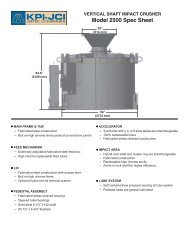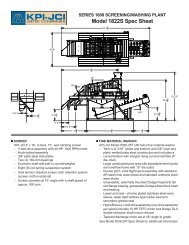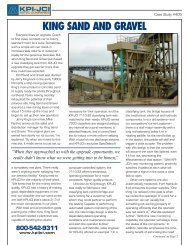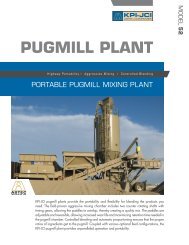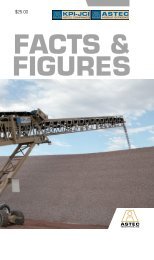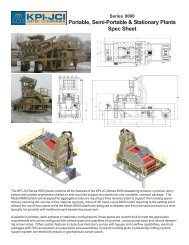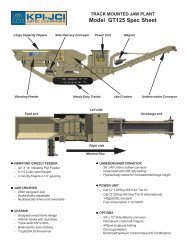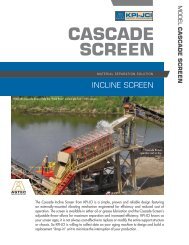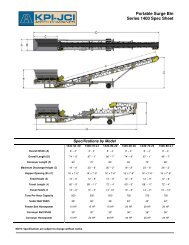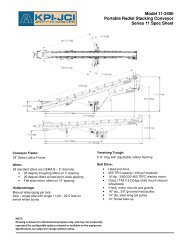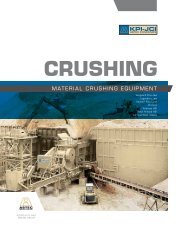Download Today's Aggregate and Mining Solutions - Vol 3 ... - KPI-JCI
Download Today's Aggregate and Mining Solutions - Vol 3 ... - KPI-JCI
Download Today's Aggregate and Mining Solutions - Vol 3 ... - KPI-JCI
- No tags were found...
Create successful ePaper yourself
Turn your PDF publications into a flip-book with our unique Google optimized e-Paper software.
ScalingScalingThings to Consider When Selecting the Method to UseWhen the different methods ofscaling are examined, thevarious options can affectthe efficiency of the operation <strong>and</strong> thecomfort <strong>and</strong> safety of miners in differentways. The following takes a closer lookat the various methods <strong>and</strong> the issuessurrounding each.MANUAL SCALINGManual scaling is done by tapping witha scaling bar (sounding) <strong>and</strong> using thebar to pry at the material, having it fallaway from the operator. This methodrequires the miner to force the bar intoa crevice or fault, twist the bar, <strong>and</strong>pry down at the same time, which isphysically dem<strong>and</strong>ing for the miner. Theminer must be lifted to the surface to bescaled in the high cut operations. Ofcourse operating at heights requires theuse of a tie off for the miner to reducethe chance of falling from the platform.There are a variety of conveyancesused such as LHD buckets, modifiedforklift trucks, high-reach platforms,manbaskets, or scissor lifts. Theproblem with this method is the extremedanger to the miner especially whenscaling a back. With this method theminer has no idea as to the physicalsize of the material or if the materialbehind is secure. When considering thejointing variables in solid rock, it is difficult for the miner to knowwhat direction the jointing is taking. The scaling bar methodtends to be more effective in sedimentary rock that has naturalpoints of entry for the bar rather than a solid rock mass.BOLTERA bolter is commonly used worldwide <strong>and</strong> it can certainlymaneuver the boom on its knuckle joint to work a back, face,or sidewall. The procedure used is “tapping or rattling.” Thisis where the drill bit taps the surface, skimming the full areabringing down faults.A bolter is designed to apply direct force hydraulically againstthe sidewall or back basically simulating a steel column holdingScissor lifts <strong>and</strong> manbaskets, sometimes used for manual scaling,are meant for lifting people <strong>and</strong> equipment – they aren’t designedfor impact. Efficiency of scaling is reduced due to the manual effortrequired.The design criteria for a bolter does not take into account droppingmaterial onto the boom or drill. While it’s tempting to do doubleduty,it ultimately increases wear <strong>and</strong> tear <strong>and</strong> therefore lack ofavailability of the bolter.a position against a hard surfacefor a period of time while the drilloperates or the bolt is inserted. Whenconsidering the time lost in moving thebolter out <strong>and</strong> bringing in secondaryequipment for scaling, the bolter canseem like the best time saving way togo. However, when considering thepurpose <strong>and</strong> strength of the bolter, itst<strong>and</strong>s to reason there would be morevibration passing through the equipmentduring scaling than when operatingnormally, as the tapping operationwould not require full hydraulic loadingto the surface being scaled. The FEAdesign criteria for a bolter does not takeinto account dropping material ontothe boom or drill which could happenduring scaling.MECHANIZED SCALERSMechanized Scalers, sometimesdesigned specifically for scaling, allowthe operator to use sight <strong>and</strong> sound todetermine what is to be scaled. Theseunits take a variety of shapes <strong>and</strong>sizes all offering either mechanizedor hydraulic systems for scaling. Notall are necessarily efficient or safedepending on the base construction <strong>and</strong>design of the unit.An ideal mechanized scaler shouldhave a swing area capable of coveringthe full width of the drift from one position, commonly 25degrees either side of center. The boom should be telescopicto allow an operator to scale from one position for as long adistance as possible without moving the machine. These abilitieswill eliminate the necessity to continually move the machineforward for the next section. Mounting a fixed blade under theboom allows the machine to clear debris in front reducing thetime to bring an LHD in to clear a path.The attachments used with the mechanical scaler are veryimportant to the effectiveness of the unit. Let’s review theattachments that are commonly used to provide a betterunderst<strong>and</strong>ing of how they work <strong>and</strong> some of the issues commonwith them.14 volume 3, number 1 | Today’s aggregate & mining solutions



